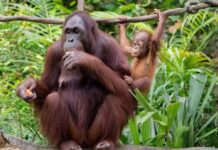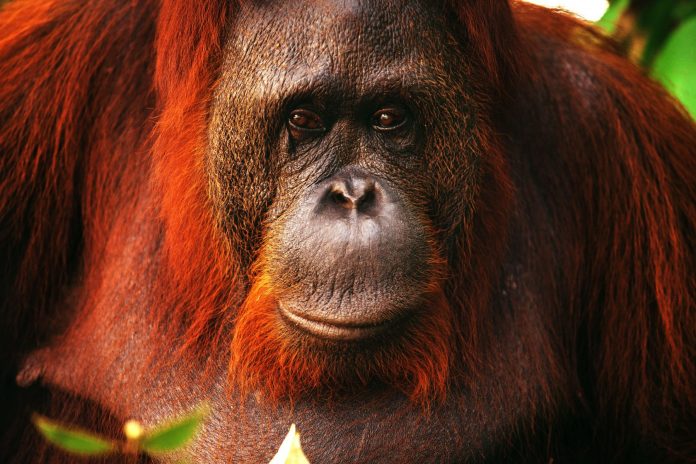
A journey into Camp Leakey Orangutan Centre to meet Tom and Tutu
By Tommy Schultz
Nearly 24 hours spent aboard the traditional wooden klotok riverboat and the only primates we’ve seen are a few proboscis monkeys cackling through the emerald green of the upper canopy. This is a poignant reminder that the population of wild orangutans here has fallen by more than 50% in the last decade.
Camp Leakey, a home for orangutans
The riverbanks narrow as we travel further into Central Kalimantan’s Tanjung Puting National Park, the tannin-stained water concealing countless fish, frogs and the occasional crocodile – the unspoken reason nobody chooses to escape the tropical heat with a quick swim.
We’re visiting Camp Leakey, the tiny research outpost created by Dr. Biruté Mary Galdikas and her staff in 1971 and named in honour of Louis Leakey, the legendary Kenyan paleoanthropologist. Today the camp has grown to become one of the leading orangutan rehabilitation facilities in the world to re-introduce these animals to their natural habitat in Borneo.
Orangutans arriving at Camp Leakey are usually orphaned, injured or formerly held in captivity. The goal of the camp is to prepare the animals to live in their natural habitat again through a process of gradual exposure. Over the course of months (and often years), Camp Leakey staff assist the animals until they are deemed ready to be released to live on their own again.
Some orangutans never really leave the camp. Having formed a bond with their human caretakers, they stay within the boundaries of their new home. These are a few of the animals that we’ll be meeting when we arrive at Camp Leakey, which has grown to become one of the most unique places in the world to have a very personal encounter with an orangutan.
Having grown up visiting zoos in big cities like Washington DC and San Diego where the boundaries between human and wildlife are very firmly drawn, it’s difficult to make a comparison with Camp Leakey.
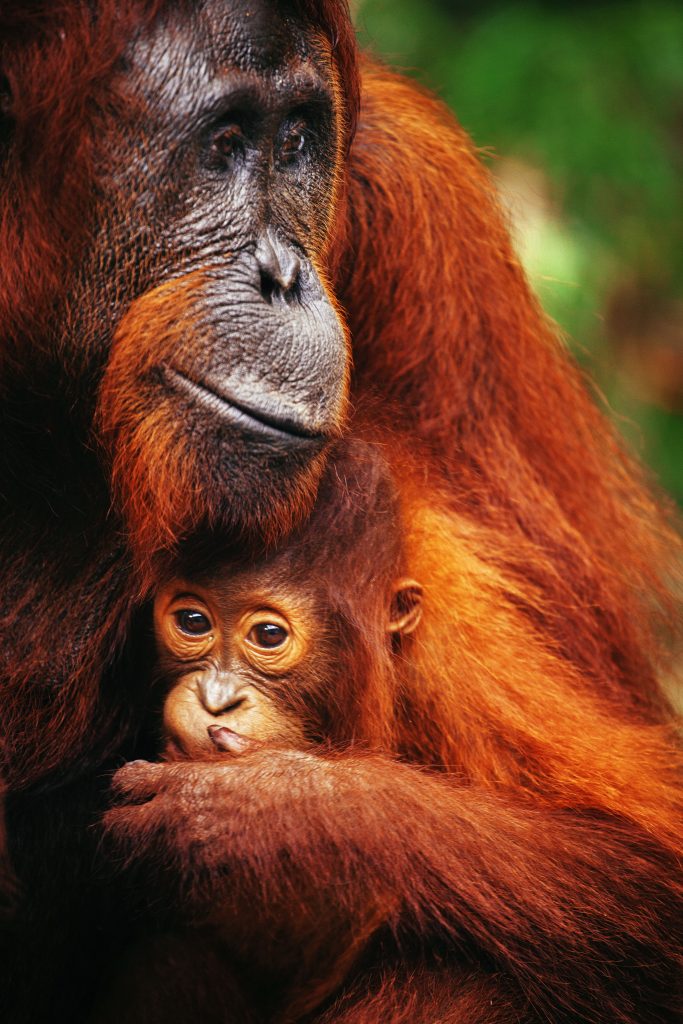
All eyes on Tutu
As our boat approaches the modest wooden dock which extends out from the swampy jungle into the river – the only visible sign of the camp – we spot our first orangutan. She’s a mature female named Tutu, holding an infant within the safety of her mahogany-coloured fur.
No humans are in sight and it’s as if the animals are really running the show here. I can already sense this is going to be an experience like no other.
Our local Dayak guide has been here many times and Tutu seems to casually acknowledge him as he steps onto the wooden planks beside her and ties our boat to the dock. Conversations stop on the boat, with all eyes on Tutu who returns our gawking stares with a steady gaze, neither alarmed nor particularly interested in the newcomers.
Raising the camera, I compose a portrait of Tutu as she turns to look into the lens. Through the clarity of the telephoto, her eyes hold a melancholy wisdom that seems to speak to the weight of her years and the existential struggle she and her species face in the coming years. Maybe I’m anthropomorphising here, but it’s hard to overstate the immediate connection everyone seems to be having with this envoy from the wilds of Borneo.
Gray, a Bali expat originally from California, approaches Tutu cautiously and sits beside her. I’m remembering the warnings about the dangers of getting too close to an animal with a baby and wondering if Gray is about to receive the thrashing of his life, but Tutu serenely ignores Gray as she cradles her infant in her enormous arms.
Adult orangutans are incredibly powerful. Males have a reach that stretches to more than two metres when fully extended and are believed to be four times stronger than humans. As the matriarchal female of the group at Camp Leakey, Tutu is a bit smaller than the largest adult male, but her strength is more than enough to completely overwhelm any of us.
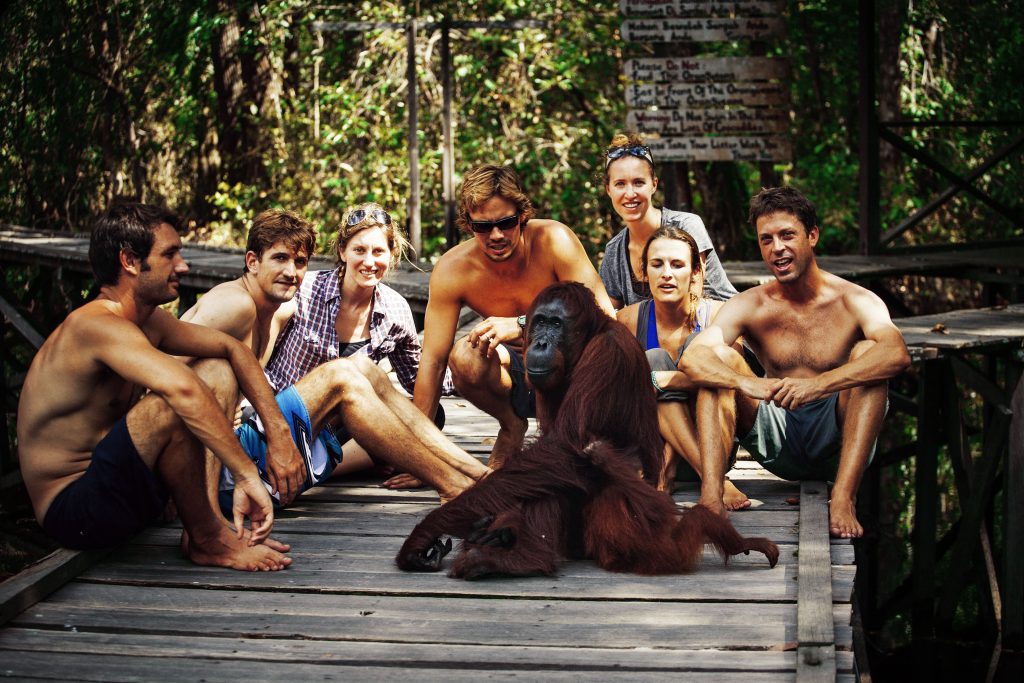
Gray is the first to reach out to Tutu, literally. Sitting cross-legged beside her, he extends his hands, palms raised. It’s the least threatening gesture he can muster, and after a tense moment, Tutu reaches out and clasps Gray’s hand in her leathery hands. Tutu is observing each of us in turn as this first gesture of friendship is made.
Seeing that Tutu is open to welcoming us to her home, everyone takes turns to greet Tutu with a handshake. While the others are interacting with Tutu, I’m trying to capture a portrait of this amazing animal that does some justice to the quiet dignity emanating from her.
Finally, it’s my turn to meet Tutu. I put the camera down and approach steadily, but slowly, careful not to make too much eye contact or flash a smile that orangutans usually interpret as a sign of aggression.
Taking a seat beside Tutu, she makes brief eye contact to acknowledge my presence, then turns her gaze to the riverboat behind me. The guides are preparing a few bananas to offer the orangutans of the camp.
Not sure exactly what to do, I offer an open hand to Tutu. She takes it in a surprisingly powerful grip, her other hand firmly grasping my forearm. I’m totally at her mercy and I’m awed (and not a little nervous) about the overwhelming strength that Tutu possesses.
Visiting Camp Leakey has already been one of the most unusual wildlife experiences I’ve ever had and we haven’t even set foot in the main camp yet.
Not wanting to disturb Tutu any longer, our guide points us towards the trail that leads to Camp Leakey. Passing several other orangutans on the short walk, they observe us casually, but none approaches to greet us as Tutu did.
Tom, the undisputed king
As we draw nearer to the cluster of buildings that are the center of Camp Leakey, our guide begins to brief us about the resident male, Tom. Tom is the undisputed king at Camp Leakey – an enormous animal with fire-orange fur and a face framed by the huge cheek pads that designate him as the alpha male of the orangutans here.
We hear Tom before we actually see him – a sonorous rumble of deep grunts and bellows echoing through the trees. I catch the first glimpse of him stretched out under the shade of a towering tree with buttress roots extending deeply into the black soil. Tom’s arms are crossed lazily, the unbelievably powerful muscles moving like constrictors beneath the dense coat of orange fur.
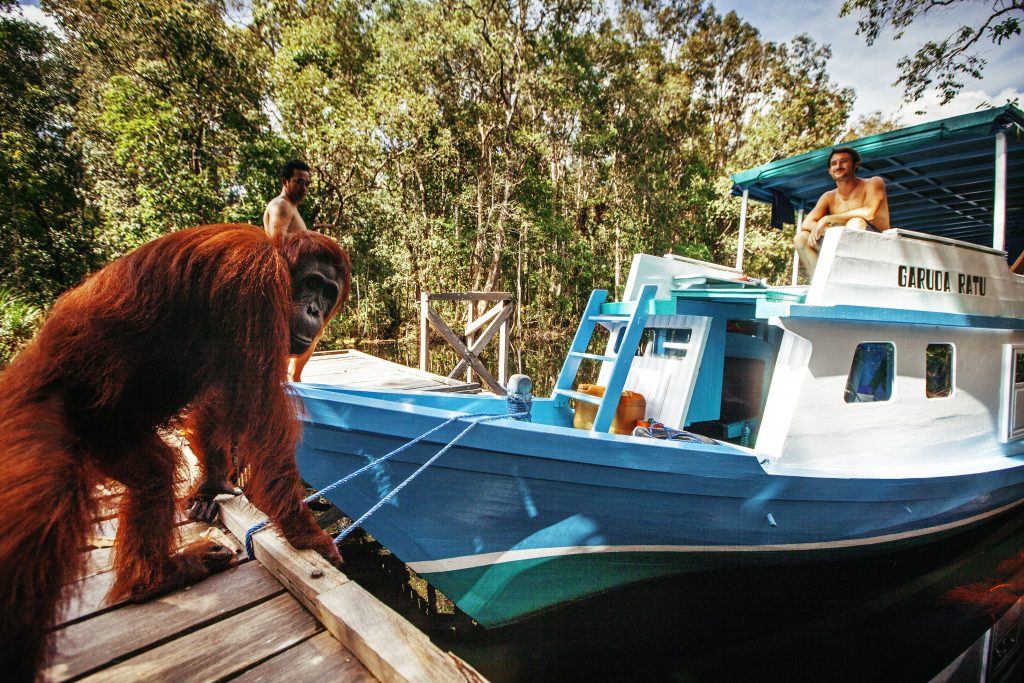
Nobody approaches Tom. In fact, there was a palpable feeling of extreme peril if anyone were foolish enough to invade his territory. I max out my zoom lens at 200mm and take a series of portraits of Tom – an entirely different experience from being near the gentle and matriarchal Tutu.
Maintaining a respectful distance from Tom, we spend the afternoon watching the antics of juvenile and sub-adult orangutans as they play and chatter with each other near watchful silence of the silent patriarch.
Eventually Tutu appears again, her infant clinging around her neck. Tutu doesn’t directly acknowledge us or Tom, but fades into the green foliage of the forest, in search of food or a bit of solitude.
The hours pass quickly here, and before I realise it’s already time to point our klotok downstream and begin the trip back to civilisation. The fiery sunset that fades in the afternoon sky above where our boat stops for the night is nearly identical to the colours of the ‘people of the forest’, the Malay translation of the name given to these gentle and wise animals.
For anyone lucky enough to travel to their native habitat to experience an interaction with Tutu and the other orangutans at Camp Leakey, the idea of losing these animals to deforestation and extinction is unthinkable. But it’s an acknowledgement of this uncertain future that I see every time I look at my favourite portrait of Tutu – her melancholy eyes expressing the sadness of a species disappearing into the growing darkness of twilight.
For more stories and photos, check out Asian Geographic Issue 116.







